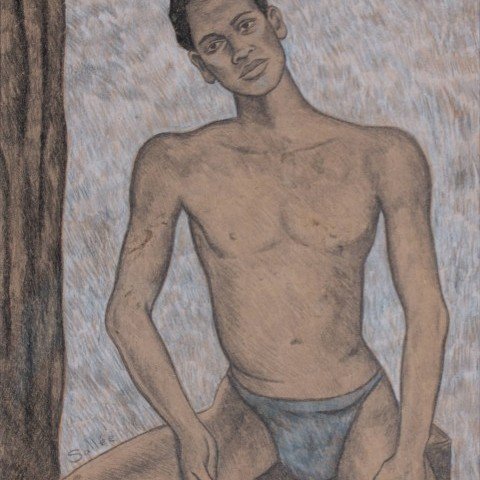Charles Louis Sallée Jr., the eldest of fourteen children, was born in Oberlin, Ohio, 1911, destined to become a renown Visual Artist and Designer. "All my life, I never wanted to be anything else but an artist," ... the words of Charles L. Sallée who recognized his calling at age four, and never changed his mind or direction. A keen sense of observation and natural inclination to draw ensured the expression of his natural talent for life.
His artistic gift found expression early on, and by the time he reached high school, Charles Sallée Jr. was regarded as an all-round artist.
After graduation from Sandusky High School in the depth of the Depression, Sallée fulfilled his dream of going to art school by winning the first Gilpin Players scholarship to the Cleveland Institute of Art (CIA). In 1936, he was the first African American to graduate from this renown institution.
He continued to win scholarships straight through his enrollment at CIA, majoring in portrait painting and minoring in design. He also studied lithography and etching techniques at the Huntington Polytechnic Institute (1932-33).
During the time Charles Sallée attended CIA, he also taught art at Karamu, a settlement house under the direction of Russell and Rowena Jelliffe, and with whom he became lifetime friends. Sallée's art at the time was described as "joyously animate.... as though the artist found nothing but transporting gladness in life."
As an active WPA artist (1936-1941), Sallée first created prints, then murals, the best of which is preserved in the office of the Outhwaite Apartment Center, called, "A New Day."
Prior to his induction into the U.S. Army, Sallée worked for the Army Map Service supervising aerial map drawings for the government. Drafted in 1943, he served his country from 1943 to 1947 in both the European and Pacific theaters of war. As a topographic draftsman he became a supervising draftsman for the Corps of Engineers making tactical maps for the U.S. Airforce.
As a Technical Sergeant, he served first in Britain as a cartographer, eventually working on maps for the Allied invasion of Europe. When the liberation came he was in France where he spent 7 months as part of the occupational force. There in reconnaissance, he helped design roads and escape routes to avoid capture by the Germans, and made road signs for the Red Ball Express (soldiers who drove supplies up to the front line). Upon his discharge, after three and one-half years in the military Sallée returned to his passion-ART!
After the war, his first important design job was for The House of Wills and then a restaurant at 55th Street near Central Avenue. Soon Sallée was designing the interiors of restaurants, bars and nightclubs, the most famous of which was the Tijuana Club on 105th Street. This then, was the beginning of a long and impressive career as an Interior Designer. Sallée's knowledge of how buildings come together (gained while he worked with his father during summers when he was a young boy) combined with his artistic training enhanced his skill of architectural drawing. It enabled him to conceptualize elaborate makeovers, as well as design original plans for both residential and commercial buildings. Sallee still considers his work with his dad as a key influence that led to his later success in the field of design. From the late 1940's through the 1970's, Charles Sallée continued to execute the decor for many East side gathering places and businesses.
By 1960, Cleveland had formed a local Chapter of the relatively new National Society of Interior Design (NSID). Charles Sallée was a charter member of this avant-garde organization now known as American Society of Interior Designers (ASID) and for many years served as Program Chair of the local Chapter. In 1962 he was reappointed to the City Planning Commission as a member of the Fine Arts Advisory by (then) mayor of Cleveland, Anthony J. Celebrezze.
Sallee Design Studio enjoyed recognition and challenging commissions throughout the 1960's, 70's and into the 1980's that included office Suites at Cleveland Municipal Stadium, the new interiors of Stouffer's Inn on the Square (now the Renaissance) and Cole Optical Stores. While expressing his ubiquitous talent in interior design, architectural renderings, figure drawing and anatomy illustration, he always found time for his first love: portrait work.
In critiquing his art or design work, Charles has always held that his work had to meet his own personal high standard. Undoubtedly, this is why public and professional recognition of his work has endured for over 65 years. Today, in both public and private venues, his work continues to be exhibited across the country.
As quoted by Art Critic, Dan Tranberg, "Charles Sallée Jr., has lived through nearly the entire history of modern art. But in Cleveland, he's done more than witness history, he's helped shape it."
Source: AskArt.com

